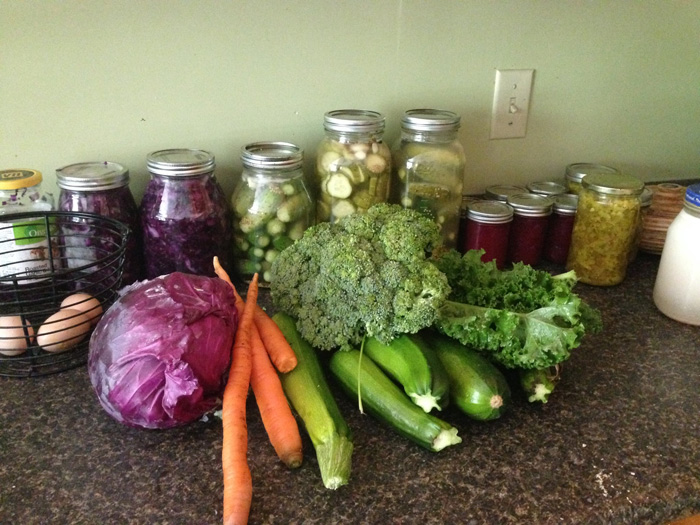Rethinking Lifestyle
Preserving the Harvest

It’s the time of year those of us who’ve attempted to garden, or stick solely to local fare, realize if we don’t eat wheelbarrow loads of one kind of veggie for a week at a time, it goes to waste quickly, and then we won’t see the same variety until next year at the same time.
Thankfully a variety of ways exist to preserve the harvest so we can enjoy our hard work throughout the year. Canning, drying, fermenting, freezing and/or preserving as-is in a fridge or root cellar all hold options. It may take a couple years to figure out what works best for you and the mouths that you feed, but meantime, let me give you a quick overview of the options.
Drying
I find drying most helpful for herbs and teas, but really anything can be dried, from vegetables to fruits to meat. Drying is easy and economical. Drying offers great benefits such as taking very little space to store the finished product. Also, by keeping the finished product in jars or reusable containers, you completely avoid plastic waste. Dried products require a cool, dark, and dry storage location and their storage is not dependant upon any hydro.
To get started, a rack or screen in a dry spot with a fan is all you need. You can also use the oven at a very low temperature. Or make an investment into a dehydrator and even more options open up.
Canning
Canning takes some time, a little practice, and a lot of jars. If your ingredients are acidic, like pickles, tomatoes, or tart jam, you can use traditional water-bath canning techniques. All you need is a large pot to act as a canner and a tried-and-true recipe that follows current safety protocol.
Plenty of other produce can be canned as well, but you may need to use a pressure canner. Pressure canning provides a perfect way to preserve meats, broths, legumes, pumpkin, beets, and really anything. Pressure canners generally range in price from $200 to $800. Sharing a pressure canner with friends or family may make the purchase more worthwhile.
Ball and Bernadine, both common brands for home canning supplies, provide excellent online and print resources, recipes and safety tips. You can also find canning safety information from the Health Canada website.
Fermenting
Fermenting offers another option. Many people ferment for health benefits, but I enjoy fermenting for the simplicity. Veggies submerged in a salt brine at room temperature transform into a pleasant and tangy ‘pickle’ after a week or so, then can be transferred to a fridge to keep up to eight months longer. Easy ferments to begin with are pickles and sauerkraut. Other vegetables that shine as ferments are green beans, hot peppers, carrots, and garlic.
Fermentation weights help keep vegetables submerged. A starter culture with active bacteria, such as whey, may also be used, but it’s not absolutely necessary. And before starting to ferment, you’ll need to make sure you have a ton of non-iodized salt on hand as you will most likely go through a lot of it!
Fermenting is not really as intimidating as it seems. Friends and neighbours with experience can provide guidance. There are also great online resources to help navigate the process.
Freezing
Freezing provides an incredibly easy and common way to store an abundance of vegetables and fruits at their peak. Most vegetables need to be blanched before freezing. Basically, that means they need to be submerged in boiling water for a minute or so, cooled off quickly in cold water, drained, and then can be frozen in single layer on a large cookie sheet. From there, scoop into reusable storage bags or containers and most vegetables stay quite well in the freezer for six to 12 months.
Storing as-is
Some produce needs no special storage techniques. Potatoes can store until the next spring in a dark cool area in a box or burlap sack. Pumpkins and squash can store for about four months at room temperature. Carrots, purple cabbage and beets can all be stored in the fridge into the winter. Just make sure you check and remove spoilage occasionally, so one bad veggie doesn’t spoil the rest.
Taking extra time in summer when the harvests are plentiful will keep you satisfied long into the winter. If it’s new to you, it may be helpful to start off slowly, and increase the percentage of home preservation every year. A great local resource to delve into local food preservation is gettystewart.com.




